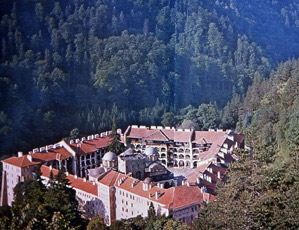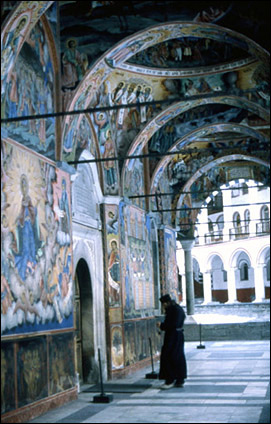| |
Rila Monastery - Bulgaria
An excerpt from Bill Hottell's unpublished memoir.
Posted: March 24, 2011
 Bill Hottell climbed a hillside to photograph the Rila Monastery, built like a Bill Hottell climbed a hillside to photograph the Rila Monastery, built like a
fortress in the extremely remote head of a valley in the Balkans.
During the five hundred years that the Ottoman Turks ruled most of the Balkan peninsula, there was a remote mountain hide-away, a single Orthodox monastery where the Bulgarian language, literature, art and culture were kept alive. Five centuries of Turkish occupation very nearly blew out the flickering light of Bulgarian identity. What saved it from extinction? The courageous and determined monks at one secluded monastery.
In a rugged mountain range in central Bulgaria, up at the head of a remote valley stands a glittering jewel of Byzantine art, a medieval monastery that stood for centuries as the sole island of Bulgarian religion and culture, a Byzantine monastery so inaccessible that even in the late 1980’s we were the first Americans to visit in years.
Diana and I had boarded a train in Istanbul and followed the Orient Express route backwards across Turkey and Bulgaria to Sofia. Next we boarded a series of battered old busses packed with Slavic peasants and rode acrossthe country and up into a narrow mountain valley to the Rila Monastery. When we checked into the only hotel in the small village, a Soviet-era structure built ten years earlier, the woman at the reception desk stared in wide-eyed disbelief at our U.S. passports. “You are the first Americans EVER to have come to this hotel.” At that moment I knew we were far off the normal tourist route.
 A monk enters the Rita Monastery from the street. Only in the Balkins are such icons displayed
outside church sanctuariea A monk enters the Rita Monastery from the street. Only in the Balkins are such icons displayed
outside church sanctuariea
At the evening mass in the monastery church I was again reminded how far off the beaten path we had come. The church was a masterpiece of medieval Byzantine art and architecture. Its outside walls were entirely covered with fresco paintings of hundreds of saints, angels and scenes from the bible. The portraits included many Eastern Orthodox saints and local Bulgarian holy men.
Inside the 16th century church, Diana and I were the only outsiders in a small congregation of bearded and black-robed monks. During the mass, which was sung in Bulgarian, the two of us received communion, a cube of bread. In our travels we usually participate in the communion service, whether it is Greek or Russian Orthodox, Serbian or Romanian Orthodox, or a Catholic mass in Europe.
When the mass was ended and the church was still filled with the smell of incense and the sounds of Bulgarian Slavic chanting, the elderly monk sitting next to me leaned over and asked, “……Ruski?” He was confident that that the only visitors to this remote monastery behind the Iron Curtain in Soviet-satellite eastern Europe would be Russians. But when I replied, ”Nyet,…Americanski,” his eyes widened in disbelief. We may have been the only Americans this cloistered monk had ever met.
During dinner at the hotel’s restaurant the staff was abuzz with the extraordinary news that two Americans had come to this distant outpost of Bulgaria. We were quietly invited to come into the kitchen after hours. The cooking staff and waiters were so desperate to learn about America they treated us like royalty and plied us with questions for hours. This was early 1989, just months before the Soviet Empire collapsed and the eastern block countries achieved independence.
As we sat in a circle the restaurant crew knew how dangerous it was to be seen talking with a westerner. The atmosphere in the kitchen was thick with secrecy and fear. They spoke in hushed tones, but the gray, Stalinesque atmosphere was explosive with the desperate urge to rebellion, to overthrow the Soviet rule.
None of them spoke English and we did not speak Bulgarian, so we used French as the common language. “What does it feel like to live in a FREE country?” “What does it feel like to have freedom of movement?” “How can you afford to travel to Bulgaria?” “What is it like living on the Twisp River?” “What are some of the things you do in Twisp?” It was exhausting to be speaking French for such a long time and to such intense listeners. Diana and I both felt humbled and privileged to be the living symbols of the free West to these Bulgarians who had lived their entire lives behind the Iron Curtain.
When the old bus arrived and drove us down the winding mountain road from the Rila Monastery, I felt deeply grateful to my childhood role model, Tom Sawyer, for that adventure spirit that had drawn me to such a remote treasure as this Bulgarian Orthodox monastery deep in the Balkans.
Spring 1989
|
|

